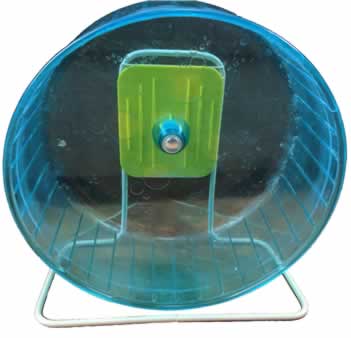
Keeping a hedgehog’s cage clean and whether it was easy or going to be difficult, was researched by my daughter. Keeping a cage clean was essential to keep the hedgehog clean and healthy.
How often do you have to clean an hedgehog’s cage? Hedgehogs cage needs to be cleaned thoroughly once a week taking everything out of the cage and washing down the cage. A partial midweek clean is required to change their bedding and running wheels with a daily clean involving removing their faeces.
We’ve come up with 5 tips to make the cleaning process easier. Our 5 tips make it easy to set up a routine to keep the cage clean and keep the smells at bay, as hedgehogs poop and pee does smell and needs to be kept in check.
1. Remove their poop daily
Our daily routine includes removing any poop in the cage and we use a little portable vacuum which effortlessly sucks up the poop. Some poop may have tried onto the bedding and this will need to be separated from the bedding. We just use one part of the bedding as a glove and then pick off the poop.
Initially, we did use a litter tray and he did poop in this but this litter training only works to some extent because if they have a running wheel, the amount of poop that gets flung out around the cage as the hedgehog is running and pooping at the same time make having the litter tray pointless.
We also found the litter tray takes up too much valuable space in the cage and compromising on the poop being spread over the cage was an easy decision to make, instead of compromising on the space the hedgehog had.
2. Change food and water daily
Depending on the food we’ve used for our hedgehog, we decide whether we’ll need to change it after a day or two. If it’s something perishable, that is it goes off quickly then any uneaten food like this will need to be removed.
We tend to predominantly use dry cat biscuits and find our hedgehog doesn’t gorge on these and overeat, some hedgehogs may do and therefore it’s wise to find out what your hedgehogs eating habits are and adjust accordingly. As our hedgehog only eats when he’s hungry, we leave ample dry biscuits in his bowl over the week.
If we decide to give him something like chicken, then I tend to not leave it in his food bowl but nearer to his house to entice him out in the evening and any leftover is thrown away.
It’s imperative to change the water every day as hedgehogs may inadvertently poop in their own water as they move around. We have two sources of water in the cage, one is the water bowl the other is the water drip. Still unsure whether he uses the water drip, as the water level does drop but that may simply be because he keeps bumping into it.
3. Clean exercise wheel regularly
The running wheel can end up with loads of dried poop on it and if this is not regularly removed, the hedgehog can get injured when using the running wheel.
It’s a tough job trying to remove the poop so what we’ve done is invested in two running wheels with the dirty wheel left to soak overnight in water whilst the other one is in use.
The following the day the wheel that was left to soak is removed from the soak and any last remaining amounts of poop are wiped of using paper towels. The wheel is then left to dry and we’re quite lucky in having a conservatory which gets pretty hot in the warmer months, so the running wheel dries very quickly.
4. Midweek partial cage clean
We do a partial clean of the cage at least once a week and generally this clean is midweek and concentrates on us changing our hedgehog’s bedding and swapping out his dirty running wheel with a clean one.

The first step in cleaning the cage is to make sure the hedgehog is put somewhere safe and we put down the new bedding in our other room downstairs and put his house on top. We put him near the house and he has a quick sniff, realises it’s his house and goes inside. He stays there while we clean his cage.
If your hedgehog is particularly inquisitive, you may need to put him inside a box as they may start to scurry around your house and the last thing you want is for your hedgehog to get stuck somewhere. We have sofas with a small clearing underneath and he used to make a dart for this, as it’s a dark place to hide.
If you do use a box, make sure it’s comfortable enough for your hedgehog and has some food because they can be quite hungry when they wake up. Or failing that, get someone else to look after them, whilst their cage is cleaned. I tend to look after him while my daughter cleans the cage, this gives her some responsibility for the hedgehog.
5. Full weekly clean
The full clean involves taking everything out of his cage and then washing the cage with soapy water. Only a very small amount of soap is mixed with the water and after the soapy water wash is completed, we rinse the cage thoroughly to ensure there is no soapy residue left behind.
I did contemplate doing this outside but I’m kind of worried about inadvertently bringing any insects or mites into the house unawares with his cage, so I use the shower room downstairs.
Newspaper bedding
The temptation may be to use newspaper as bedding, as this can be a cheap source of bedding and cleaning is as simple as taking the old newspaper bedding, throwing it away and replacing it with new newspaper bedding.
However, I’m not a big fan of newspaper bedding, as the ink used could be toxic, so I’d be worried about our hedgehog eating the newspaper and getting sick.
Newspaper bedding isn’t as absorbent as the cloth based bedding we use, so any water spillage or pee on the newspaper bedding won’t soak in as well as cloth bedding. As the hedgehog moves around, this could turn mushy and if it’s cold make the floor area where the soaked newspaper bedding is colder.
Fabric-based bedding
The fabric-based bedding we use is about a centimetre thick, that’s about a third of an inch, giving it plenty of ability to absorb our hedgehog’s pee and any water spillages from his bowl or his water tube.

Whilst using other types of bedding like cloth-based bedding involves having to wash these regularly making it feel as though it’s quite a chore, however it is definitely worth the effort. We have brought three cloth-based bedding, which is alternated, with at least one in the wash, one at hand and one being used.
Wood Shavings
We don’t also use shavings as again these may not be good enough to absorb any pee or water. So the hedgehog could again be walking in their own pee or through cold water.
Cloth Tunnel
We also have a cloth-based tunnel which our hedgehog likes to snuggle in sometimes and occasionally he can leave poop or he pees inside this tunnel. Maybe he becomes just a little bit too relaxed and forgets his manners 😊. Again we have two of these cloth-based tunnels and wash these alternately.

With any fabric bedding, the machine washing is the easy part, the drying is the problem especially in the cold months. The temptation may be too leave bedding on heaters and radiators but this can increase the moisture in your house and if it’s not adequately ventilated the mould.
We have a dryer in our utility room which is well ventilated, so it’s quite easy to dry the bedding and in the warmer months when our conservatory becomes a sun trap, we just leave the bedding here to dry.
We use a soft detergent which doesn’t have too many chemicals in and we have found it to be gentle especially with our daughter who used have outbreaks of eczema and when we changed the detergent to the current one, the eczema outbreaks fell dramatically.
Some detergents can have many chemicals which may remain even after washing, so it’s best to find one which is pet-friendly.
We also use cloth-based house cover as the plastic house isn’t dark enough for our hedgehog and this needs washing too. Fortunately, this doesn’t get too dirty, so can be washed less frequently.
Don’t go overboard and clean do a full clean every day, it’s just not worth the effort and doesn’t have any additional benefit. Moreover, it may become a burdensome chore which inevitably could lead to arguments or even an abrupt stopping of cleaning regularly altogether.
Scented cleaning products are a no-no
Don’t use scented cleaning products as hedgehogs have an incredible sense of smell and they may get distressed with scents and smells. It’s also important to remember any cleaning products used are not toxic for hedgehogs, as the last thing any hedgehog owner would want is for their hedgehog to become sick or worse still die from improper use of cleaning products.
Finally, the weekly system you use for your hedgehog will be based on compromises and trying to find the right balance of cleanliness. It took us a few weeks to perfect our system of cleaning and one established as a routine, it’s been fairly easy to maintain.
With the exception of vacations where the person looking after our hedgehog doesn’t have to do the full clean at the end of each week when we are away on holiday. This has the benefit of making it easier for us to find friends and family who are prepared to look after our hedgehog.
Conclusion
Daily cleaning is required for removing our hedgehog’s poop from the cage and also changing his food and water. Cleaning his exercise wheel, with a light clean of the cage can be done in the middle of the week. With a full clean of the cage done once a week.
Related Questions
How often do you bathe your hedgehog? Every 2 weeks we bathe our hedgehog and this along with our cleaning routines for his cage, ensures he doesn’t get too dirty in between these bath times.
Do hedgehogs smell? Yes, they do but by cleaning their cages regularly you can minimize on the poop that ends up on their feet and fur, alleviating the smell. We remove poop from our hedgehog’s cage on a daily basis.






